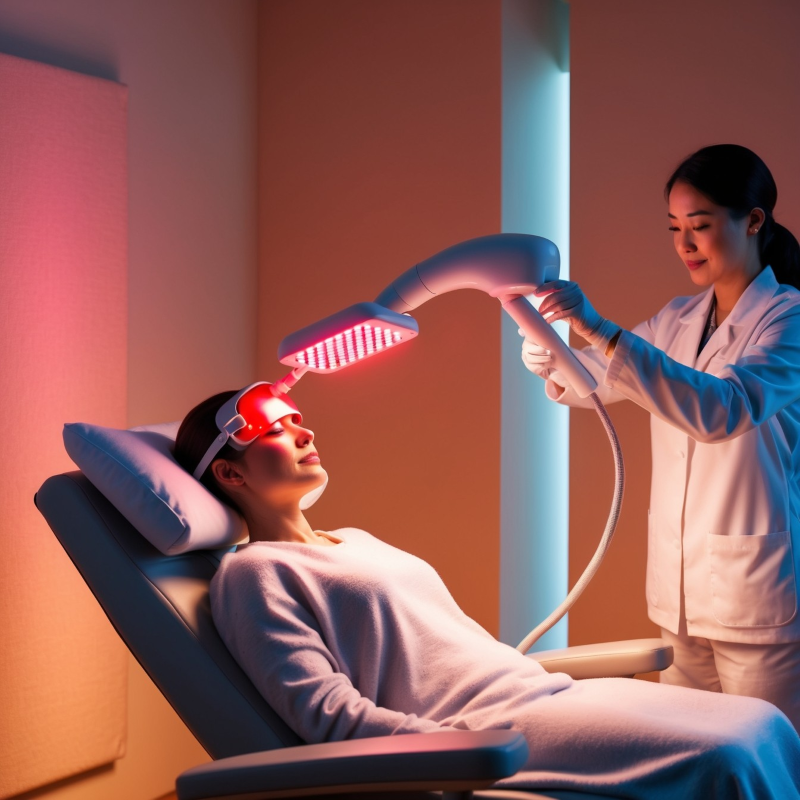Promoting Mitochondrial Health in Parkinson’s Disease

Mitochondria, often called the “powerhouses” of cells, play a crucial role in generating energy, regulating cellular metabolism, and maintaining overall cell health. In neurodegenerative diseases like Parkinson’s, mitochondrial dysfunction contributes significantly to neuronal damage and disease progression. Therefore, promoting mitochondrial health is a vital component of light-based therapies, especially photobiomodulation (PBM), in Parkinson’s management.
How Light-Based Therapies Improve Mitochondrial Health
- Enhanced Energy Production:
PBM stimulates cytochrome c oxidase, a key enzyme in the mitochondrial respiratory chain, leading to increased ATP (adenosine triphosphate) production. By boosting ATP levels, PBM helps maintain neuronal energy supply, which is often compromised in Parkinson’s disease. This energy boost supports better cellular function, including motor neuron signaling, and can improve overall motor control. - Reduction of Oxidative Stress:
Mitochondria in Parkinson’s patients often generate excessive reactive oxygen species (ROS), leading to oxidative stress, a major factor in neuronal damage. PBM enhances the antioxidant capacity of cells, reducing oxidative stress by increasing the production of antioxidant enzymes like superoxide dismutase (SOD) and catalase. This protective effect helps mitigate damage to dopamine-producing neurons, which are particularly vulnerable to oxidative stress. - Support for Neuroprotection:
Mitochondrial health is closely linked to the survival of dopamine-producing neurons in the substantia nigra. By improving mitochondrial function, PBM enhances cellular resilience, reducing apoptosis (programmed cell death) and promoting neuron survival. This effect is crucial for slowing disease progression and preserving motor function in Parkinson’s patients. - Improvement of Mitochondrial Biogenesis:
PBM has also been shown to stimulate mitochondrial biogenesis, the process by which cells increase their mitochondrial count. More mitochondria mean increased energy production, better cellular health, and improved capacity for neural repair, all of which are beneficial for managing Parkinson’s symptoms. This aspect of PBM is particularly promising, as it supports long-term cellular health and resilience against ongoing neurodegeneration.
Clinical Implications of Mitochondrial Support in Parkinson’s
- Improved Motor Function:
By boosting mitochondrial function and energy production, PBM can enhance motor performance in Parkinson’s patients. Clinical studies have reported improvements in tremor control, gait stability, and overall motor coordination, with patients experiencing more fluid and precise movements. - Better Non-Motor Outcomes:
Since mitochondria also influence non-motor functions like cognition and mood, improved mitochondrial health can translate into enhanced cognitive performance, mood stability, and better mental clarity. Patients undergoing regular PBM sessions have reported improvements in focus, memory, and emotional well-being, suggesting broader neuroprotective benefits. - Delaying Disease Progression:
Supporting mitochondrial health may help slow the progression of Parkinson’s disease by reducing oxidative damage, preserving dopaminergic neurons, and sustaining energy levels in affected brain regions. This makes PBM a valuable tool for not only symptom management but also potential neuroprotection.
Challenges and Future Directions for Mitochondrial Health
- Optimizing Light Parameters:
Achieving the right wavelength, intensity, and duration of PBM is critical to effectively targeting mitochondria. Ongoing research is focused on refining these parameters to maximize the neuroprotective and energy-enhancing effects of PBM in Parkinson’s patients. - Personalized Treatment Protocols:
Since individual mitochondrial health varies based on disease severity, stage, and other factors, personalized PBM protocols may be more effective in delivering optimal results. Tailored treatment plans that consider a patient’s specific mitochondrial status could further enhance the effectiveness of light-based therapies in Parkinson’s.
By directly targeting mitochondrial health, PBM offers a promising avenue for improving symptoms, slowing neurodegeneration, and enhancing quality of life in Parkinson’s disease. Continued research and clinical trials will be essential to optimize its use and integrate it into comprehensive Parkinson’s management strategies.
SEO Keywords (at end of the post): light therapy, neurodegenerative disease, Parkinson’s, Alzheimer’s, photobiomodulation
AI-generated medical content is not a substitute for professional medical advice or diagnosis; I hope you found this blog post informative and interesting. www.parkiesunite.com by Parkie
DALL-E Prompt: A watercolor image illustrating a calm, healing light therapy session in a serene clinical environment. The setting features a comfortable reclining chair, soft natural lighting, and a focused medical professional applying a device emitting gentle red and near-infrared light to a patient’s head. The room is designed to feel peaceful and therapeutic, with warm, soothing colors and soft textures, symbolizing the non-invasive treatment of neurodegenerative diseases.